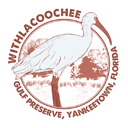Author Roger Drouin recently toured the Preserve guided by David Kaplan and Katie Glodzik from the University of Florida Department of Environmental Engineering Sciences. Using information from his visit he discusses the effects of rising sea levels on Gulf coastal forests in this article in Yale Environment 360.
E360 REPORT – Ghost Forests: How Rising Seas Are Killing Southern U.S. Woodlands
A steady increase in sea levels is pushing saltwater into U.S. wetlands, killing trees from Florida to as far north as New Jersey. But with sea level projected to rise by as much as six feet this century, the destruction of coastal forests is expected to become a worsening problem worldwide.
Yale Environment 360 is a publication of the Yale School of Forestry & Environmental Studies.



 The
The 

 Gopher tortoises (Gopherus polyphemus) are long-lived reptiles native to the southeastern United States. They occupy upland habitat throughout Florida including forests and pastures. Gopher tortoises are herbivore scavengers and consume a variety of plants, including grasses and terrestrial legumes. (Photo by FWC Research)
Gopher tortoises (Gopherus polyphemus) are long-lived reptiles native to the southeastern United States. They occupy upland habitat throughout Florida including forests and pastures. Gopher tortoises are herbivore scavengers and consume a variety of plants, including grasses and terrestrial legumes. (Photo by FWC Research)